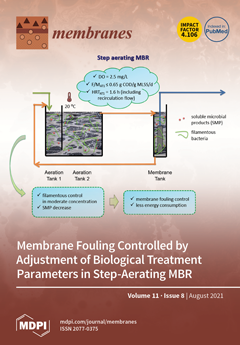In recent years, mixed matrix membranes (MMMs) have received worldwide attention for their potential to offer superior gas permeation and separation performance involving CO
2 and CH
4. However, fabricating defect-free MMMs still remains as a challenge where the incorporation of fillers
[...] Read more.
In recent years, mixed matrix membranes (MMMs) have received worldwide attention for their potential to offer superior gas permeation and separation performance involving CO
2 and CH
4. However, fabricating defect-free MMMs still remains as a challenge where the incorporation of fillers into MMMs has usually led to some issues including formation of undesirable interfacial voids, which may jeopardize the gas separation performance of the MMMs. This current work investigated the incorporation of zeolite RHO and silane-modified zeolite RHO (NH
2–RHO) into polysulfone (PSf) based MMMs with the primary aim of enhancing the membrane’s gas permeation and separation performance. The synthesized zeolite RHO, NH
2–RHO, and fabricated membranes were characterized by X-ray diffraction (XRD) analysis, Fourier transform infrared-attenuated total reflection (FTIR-ATR), thermogravimetric analysis (TGA) and field emission scanning election microscopy (FESEM). The effects of zeolite loading in the MMMs on the CO
2/CH
4 separation performance were investigated. By incorporating 1 wt% of zeolite RHO into the MMMs, the CO
2 permeability and ideal CO
2/CH
4 selectivity slightly increased by 4.2% and 2.7%, respectively, compared to that of a pristine PSf membrane. On the other hand, a significant enhancement of 45% in ideal CO
2/CH
4 selectivity was attained by MMMs incorporated with 2 wt% of zeolite NH
2-RHO compared to a pristine PSf membrane. Besides, all MMMs incorporated with zeolite NH
2-RHO displayed higher ideal CO
2/CH
4 selectivity than that of the MMMs incorporated with zeolite RHO. By incorporating 1–3 wt% zeolite NH
2-RHO into PSf matrix, MMMs without interfacial voids were successfully fabricated. Consequently, significant enhancement in ideal CO
2/CH
4 selectivity was enabled by the incorporation of zeolite NH
2–RHO into MMMs.
Full article






